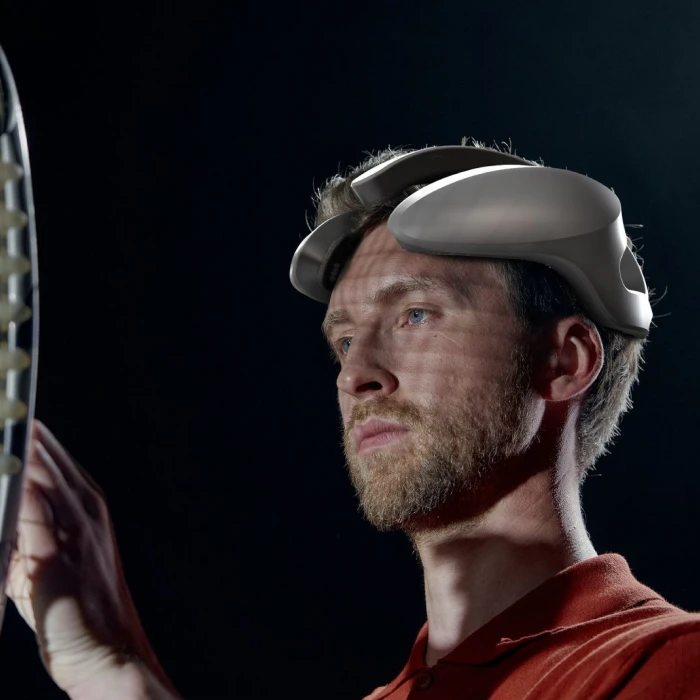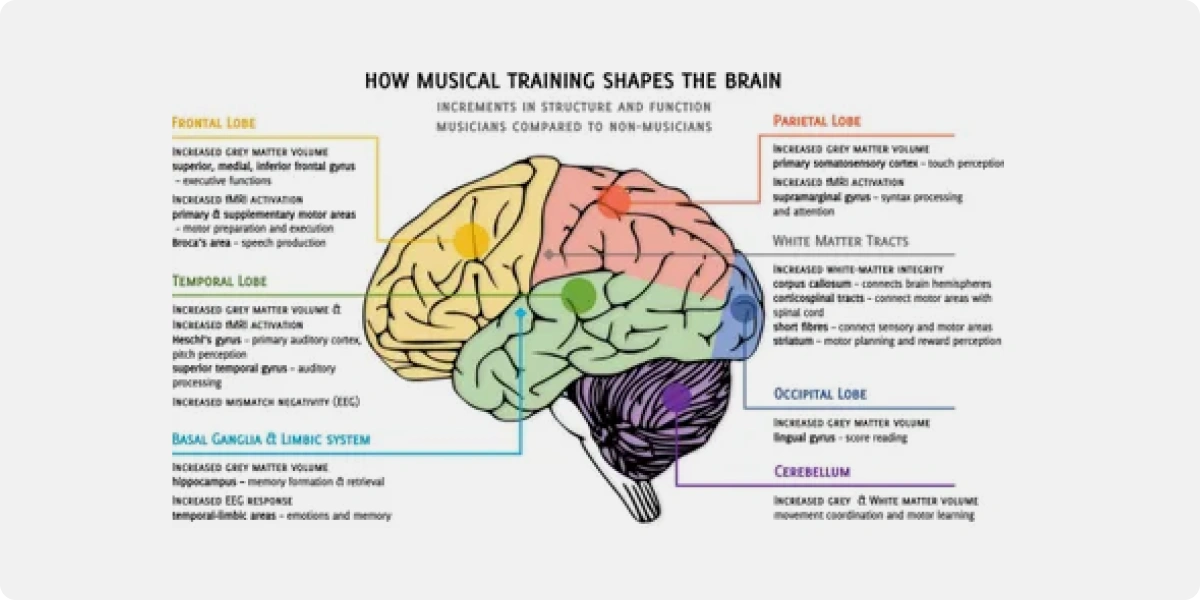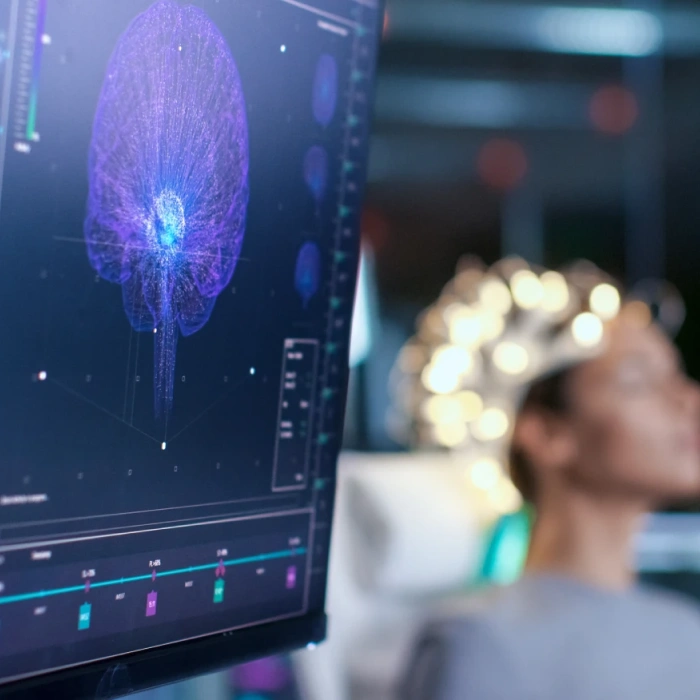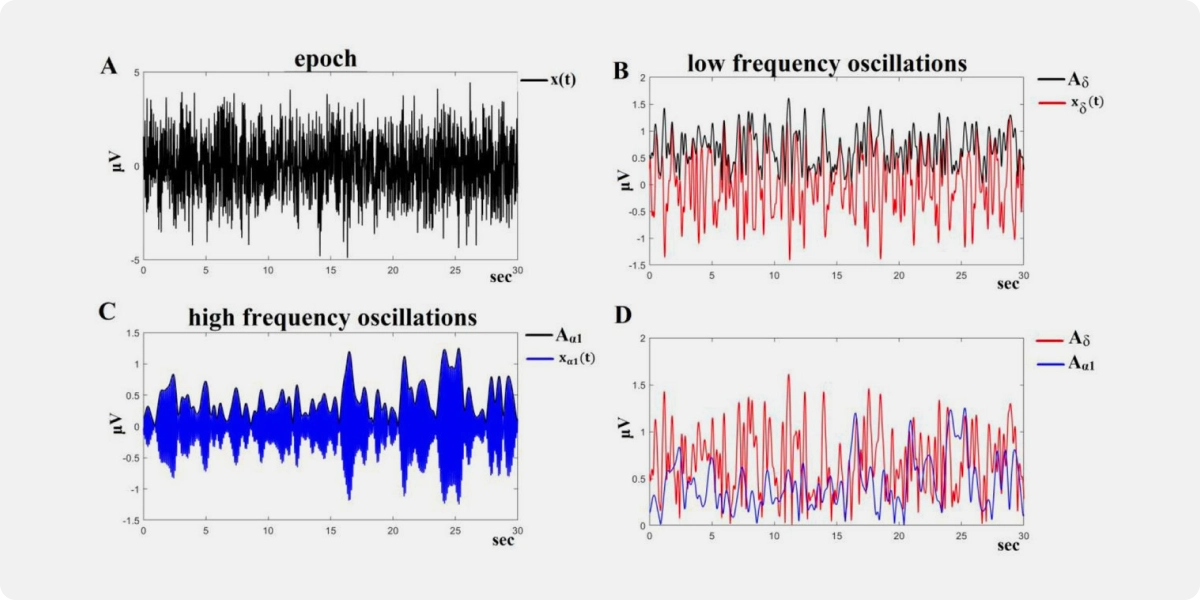What is Brain-Computer Interface (BCI) and how does it work?
Explore what constitutes Brain-Computer Interface technology and what are some of the applications of the technology.

The idea of connecting the brain to technology has always fascinated researchers, and it has now become a reality thanks to recent advancements in neurology and engineering. Nexstem is an innovator in Brain-Computer Interface(BCI) technology, unlocking the true potential of human-machine interactions. Our mission is to revolutionize the industry of neuroscience, healthcare, gaming, and beyond through our comprehensive BCI ecosystem.
What is BCI?
A Brain-Computer Interface (BCI) is a technology that facilitates direct communication between the brain and external devices, allowing for control or interaction without needing physical movement. BCI technology acquires brain signals, analyzes them, and translates them into commands relayed to output devices to carry out desired actions. It is often used for research and to enhance human cognitive or sensory-motor functions
BCI Applications
BCI has contributed immensely to various research fields, including medicine, neuromarketing, gaming, and beyond, revolutionizing how we interact with technology and unlocking new possibilities such as controlling devices through mere thought. For instance, in medicine, BCI has enabled groundbreaking experiments such as the one conducted by Dr. Miguel Nicolelis and his team at Duke University. They developed a BCI system that allowed monkeys to control robotic arms using only their thoughts, paving the way for potential applications in prosthetics for paralyzed individuals (Nicolelis et al., 2003). In neuromarketing, researchers have utilized BCI technology to measure consumers' neural responses to advertisements and products, providing valuable insights into consumer preferences and behavior (Vecchiato et al., 2010). In the gaming industry, companies like CTRL-labs have developed BCI-enabled devices that allow players to control video games using their brain signals, creating immersive gaming experiences (CTRL-labs, 2019). These experiments showcase the diverse applications and potential of BCI technology across different fields, highlighting its transformative impact on human-computer interaction.
How does BCI work?
The functioning of our brains is what enables BCI to operate. Our brains contain neural cells known as neurons, which are interconnected by axons and dendrites. Neurons become active whenever we move, feel, think, or recall anything. Small electric signals, traveling as quickly as 250 mph from neuron to neuron, facilitate these tasks. These signals are generated on the membrane of each neuron based on the potential ions carry. When these signals escape, they can be detected and interpreted by scientists. BCI technology captures these signals to enable communication between the brain and external devices, allowing for various applications such as controlling prosthetic limbs, typing on a computer, or even playing video games through thought alone.
EEG based BCI
EEG is one of the most rapidly developing technologies under BCI. An electroencephalogram (EEG) is a test used to evaluate the electrical activity in your brain, helping to detect potential problems with brain cell communication. Thanks to Hans Berger's discovery in 1924, EEG became possible. Since this discovery, additional brainwave types and their associated mental states have been identified. With BCI systems, users can operate an external actuator almost in real time via an EEG system. Through the use of EEG-based BCI equipment, a person might operate a computer or other device with just their thoughts, eliminating the need for typical computer operation techniques such as using their hands. These EEG devices can be used to track a subject's cognitive states such as emotions, concentration, and behaviors.
Conclusion
Brain-computer interface (BCI) technology represents an exciting frontier in human-machine interaction. Its potential to enhance accessibility, improve healthcare, and revolutionize entertainment is truly remarkable. As we continue to explore and refine BCI applications, it's clear that this technology can profoundly impact our lives in ways we have only begun to imagine. The progress made by companies like Nexstem in developing comprehensive BCI ecosystems is a testament to the boundless possibilities of merging neuroscience with engineering. With further advancements and widespread adoption, BCI has the potential to empower individuals and transform industries, making science fiction a tangible reality.Are you passionate about neuroscience, gaming, or healthcare? If you're an industry leader, researcher, developer, or enthusiast, join us in creating groundbreaking BCI applications and shaping the future of human-machine interactions.
Resources and further reading
- Brain computer interfacing: Applications and challenges - ScienceDirect
- EEG-Based Brain-Computer Interfaces
- Current Status, Challenges, and Possible Solutions of EEG-Based Brain-Computer Interface: A Comprehensive Review - PMC
- Brain-Computer Interface: Advancement and Challenges - PMC
Other Sources
- Brain Computer Interface (BCI): Technology, Types And Applications
- Brain-Computer Interfaces (BCI) Explained | Built In
- How Brain-Computer Interfaces Work | HowStuffWorks

In the exciting world of neuroscience, the collaboration of BCI technology with AI steers in a promising phase of expansion and development. At Nexstem, we are at the forefront of this revolution.
In the exciting world of neuroscience, the collaboration of Brain-Computer Interface (BCI) technology with Artificial Intelligence (AI) steers in a promising phase of expansion and development. At Nexstem, we are at the forefront of this revolution, leveraging cutting-edge hardware and software to unlock the full potential of BCI systems. Let's take a journey as we delve into how AI is changing the landscape of BCI technology and the remarkable impact it holds for the destiny of neuroscience.
Introduction to BCI and AI
A Brain-Computer Interface (BCI) is a technology that facilitates direct communication between the brain and external devices, allowing for control or interaction without needing physical movement. In contrast, AI boosts devices to gain knowledge from data, adjust to new information, and carry out tasks smartly. When combined, BCI and AI chart a course for ground-breaking applications that revolutionize the interaction between humans and machines.
Integrating AI into BCI System
AI-based methods including machine learning, deep learning, and neural networks have been thoroughly blended into BCI systems, ramping up their utility, effectiveness, and user-friendliness. The power of AI algorithms allows BCI systems to decode intricate brain signals, cater to individual user needs, and fine-tune system engagements on the fly.
One such example is the combination of machine learning algorithms, particularly deep learning methods, with EEG-based BCIs for motor imagery tasks.
Motor imagery involves imagining the movement of body parts without physically executing them. EEG signals recorded during motor imagery tasks contain patterns that correspond to different imagined movements, such as moving the left or right hand. By training deep learning models, such as convolutional neural networks (CNNs) or recurrent neural networks (RNNs), with large datasets of EEG recordings from motor imagery experiments, researchers can develop highly accurate classification algorithms capable of decoding these intricate brain signals.
For instance, studies have shown that CNNs trained on EEG data can achieve remarkable accuracy in classifying motor imagery tasks, enabling precise control of BCI-driven devices like prosthetic limbs or computer cursors. Furthermore, incorporating techniques like transfer learning, where pre-trained CNN models are fine-tuned on smaller, task-specific datasets, can facilitate the adaptation of BCI systems to individual user preferences and neurophysiological characteristics.
Moreover, advancements in reinforcement learning algorithms offer opportunities to dynamically adjust BCI parameters based on real-time feedback from users. By continuously learning and adapting to user behavior, reinforcement learning-based BCI systems can optimize system engagements on the fly, enhancing user experience and performance over time.
Signal Processing and Analysis
Artificial Intelligence is instrumental in the world of signal processing and analysis when it comes to Brain-Computer Interface systems. It uses cutting-edge algorithms for specific feature extraction, sorting brain signals, and removing unnecessary noise, all of which make the data collected more accurate and trustworthy. These data yield critical understanding about brain functioning, opening doors for myriad applications.
Specific algorithms are commonly employed for various tasks in signal processing, particularly in feature extraction.
Feature Extraction Algorithms
Advanced signal processing algorithms such as Common Spatial Patterns (CSP), Time-Frequency Analysis (TFA), and Independent Component Analysis (ICA) are extensively utilized for precise feature extraction in BCI systems. These algorithms are specifically designed to identify and extract relevant patterns in brain signals associated with specific mental tasks or intentions.
Noise Reduction Techniques
Despite their effectiveness, BCI systems often encounter various types of noise, including electrical interference, muscle activity artifacts, and environmental factors. To ensure the integrity of neural signals, sophisticated noise reduction techniques are employed.
Types of Noise and Mitigation Techniques
Electrical Interference: Adaptive filtering techniques are employed to suppress electrical interference from surrounding equipment.
Muscle Activity Artifacts: Artifact removal algorithms, such as Independent Component Analysis (ICA), are utilized to eliminate muscle activity artifacts from the recorded signals.
Environmental Factors: Spatial filtering methods like Common Spatial Patterns (CSP) are implemented to mitigate the impact of environmental noise.
Ensuring Data Quality
These noise reduction techniques are crucial for maintaining the quality and reliability of the collected data, ensuring that it is suitable for subsequent analysis and interpretation. By effectively suppressing unwanted noise, BCI systems can provide accurate and trustworthy data for various applications.
Adaptive and Intelligent Interfaces
The role of AI is crucial in creating intelligent and customizable interfaces for BCI systems. It ensures a personalized, responsive, and predictive modeling based on user habits. These interfaces significantly improve user involvement, productivity, and satisfaction in numerous applications.
Let's delve into a case study that exemplifies the fusion of AI and BCI technology
Primary Technology
The Crown, a specialized EEG headset, focuses on BCIs employing EEG technology for real-time cognitive state monitoring and interaction.
Use Case(s)
The Crown utilizes machine learning algorithms to interpret EEG data, providing actionable metrics on cognitive states such as focus and emotional well-being. Designed for both consumers and developers, it interfaces with various platforms, serving diverse use cases from productivity enhancement to research.
Example Experiences
1. Music Shift
Music Shift utilizes The Crown's EEG capabilities to measure the brain's response to music, identifying songs that enhance concentration. The app connects with Spotify Premium accounts to curate playlists that maintain focus and promote a flow state.
2. Mind-controlled Dino game (Created by Charlie Gerard)
This project leverages The Crown to train specific thoughts, like tapping the right foot, to control actions in Chrome's Dino game. By interpreting EEG signals, users can interact with the game solely through their brain activity.
3. Brain-controlled Coffee Machine (Created by Wassim Chegham)
Using the Notion 2 headset, this project detects thoughts of moving the left index finger, triggering a coffee machine to brew and serve an Espresso via Bluetooth Low Energy (BLE). The integration of BCI technology allows users to control devices through their brain signals, enhancing convenience and accessibility.
In summary, The Crown exemplifies the integration of AI and BCI technology to create adaptive and intelligent interfaces. By leveraging machine learning algorithms and EEG technology, it enables a range of innovative experiences, from enhancing concentration with personalized music playlists to controlling devices through brain signals, ultimately improving user engagement and satisfaction.
Enhanced User Experience
BCI systems powered by AI play a vital role in augmenting user interaction by offering intuitive controls, minimizing mental burden, and encouraging more natural paradigms of interaction. Users can effortlessly undertake complex tasks and liaise with external devices, paving the way for a mutually beneficial partnership between humans and machines.
For instance, one example of intuitive controls is brain-controlled cursors, where users can move a cursor on a screen simply by imagining the movement of their limbs. This approach eliminates the need for traditional input devices like mice or touchpads, reducing physical effort and cognitive load for users.
Another intuitive control mechanism is the use of predictive typing interfaces, where AI algorithms analyze users' brain signals to anticipate their intended words or phrases. By predicting users' inputs, these interfaces can speed up the typing process and alleviate the cognitive burden associated with manual typing, particularly for individuals with motor impairments.
Furthermore, gesture recognition systems, integrated with AI algorithms, enable users to control devices through natural hand movements or gestures detected by wearable sensors. By translating hand gestures into commands, these systems offer a more intuitive and expressive means of interaction, resembling natural human communication.
Improving Performance and Accuracy
Artificial Intelligence (AI) is essential in enhancing the efficiency and precision of Brain-Computer Interface (BCI) systems by leading the progress in decoding algorithms, error rectification methods, and adaptive learning models. By ceaselessly learning from user responses and refining the dissection of data, AI endows BCIs to attain unparalleled degrees of detail and dependability.
Applications in Healthcare and Rehabilitation
Healthcare and rehabilitation procedures are being revolutionized by AI-enhanced BCI systems. This shift encompasses assistive technology, neurorehabilitation, and the diagnosis of brain-related conditions. These systems present innovative methods for enhancing health results and standard of living, laying a foundation for individualized and evidence-based strategies
Challenges and Future Directions
Despite AI's enormous promise in BCI creation, there are still periods of difficulty yet to be navigated, encompassing issues like the acquisition and utilization of brain data, comprehension capabilities, and ethical questions. One of the main challenges lies in the availability and quality of brain data required for training AI algorithms in BCI systems. Access to large, diverse, and well-curated datasets is essential for developing accurate and robust models capable of decoding complex brain signals effectively.
Furthermore, ethical considerations surrounding the collection, storage, and usage of brain data present significant challenges in the field of AI-powered BCIs. Safeguarding user privacy, ensuring informed consent, and addressing concerns related to data security and potential misuse are paramount. The ethical implications of BCI technology extend beyond individual privacy to broader societal concerns, including the potential for discrimination, surveillance, and unintended consequences.
Tackling these hurdles and outlining the path ahead for exploration, as well as innovation, is crucial for unlocking the comprehensive potential of AI-powered BCI systems and progressing within the neuroscience domain. Addressing the challenges of brain data acquisition and ethical considerations not only facilitates the development of more reliable and ethically responsible BCI technologies but also fosters trust and acceptance among users and stakeholders. By prioritizing ethical principles and responsible practices, the BCI community can pave the way for the ethical and equitable deployment of AI-driven neurotechnologies in diverse applications, from healthcare to assistive technology and beyond.
Conclusion
In the world of neuroscience and technology, combining Brain-Computer Interface (BCI) with AI represents a remarkable convergence of human ingenuity and technological innovation. It's like bringing together our brains and technology to do amazing things. But as we explore this new frontier, it's important to remember to do it right.
We need to make sure we are using AI and BCI in ways that respect people's privacy and rights. By working together and being open about what we're doing, we can ensure that the benefits of BCI technology are accessible to all while safeguarding the privacy and dignity of individuals.

Learning to play a musical instrument not only enhances your musical skills but also reshapes the adult brain. Discover how musical training bridges nature and nurture, transforming both brain structure and function.
Music has long been known to have a profound impact on our emotions and well-being. But did you know that learning to play a musical instrument can also shape the adult brain? In a recent review article, researchers delve into the structural and functional differences between the brains of musicians and non-musicians, shedding light on the fascinating effects of musical training.
Nature vs. Nurture: Predispositions or Training?
One of the key questions in this inquiry is whether the observed differences between musicians and non-musicians are due to inherent predispositions or the result of training. Recent research explores brain reorganization and neuronal markers related to learning to play a musical instrument. Turns out, the "musical brain" is influenced by both natural human neurodiversity and training practice.
Structural and Functional Differences
There are structural and functional differences between the brains of musicians and non-musicians. Specifically, regions associated with motor control and auditory processing show notable disparities. These differences suggest that musical training can lead to specific adaptations in these brain areas, potentially enhancing motor skills and auditory perception.
Impact on the Motor Network and Auditory System
Longitudinal studies have demonstrated that music training can induce functional changes in the motor network and its connectivity with the auditory system. This finding suggests that learning to play an instrument not only refines motor control but also strengthens the integration between auditory and motor processes. Such cross-modal plasticity may contribute to musicians' exceptional ability to synchronize their movements with sound.

Predictors of Musical Learning Success
Research has also found potential predictors of musical learning success. Specific brain activation patterns and functional connectivity are possible indicators of an individual's aptitude for musical training. These findings open up exciting possibilities for personalized approaches to music education, allowing educators to tailor instruction to each student's unique neural profile.
Some generic predictors, however, are:
Attitude and Motivation
Positive attitudes towards the music being learned and high motivational levels have emerged as significant predictors of musical learning success. Individuals displaying enthusiasm and a receptive mindset exhibit enhanced learning outcomes, underscoring the importance of psychological factors in the musical learning process.
Intelligence
General intelligence demonstrates a positive correlation with musical skill acquisition, suggesting that cognitive aptitude plays a pivotal role in mastering musical elements. This finding underscores the cognitive demands of musical learning and emphasizes the relevance of intelligence as a predictor of success in this domain.
Reward and Pleasure
The level of liking or enjoyment of a particular piece of music before training has been identified as a critical predictor influencing the ability to learn and achieve proficiency. The intrinsic reward and pleasure associated with musical engagement contribute to heightened receptivity and commitment to the learning process.
Music Predictability
Musical predictability emerges as a noteworthy factor influencing pupil dilation and promoting motor learning in non-musicians. The predictability of musical elements contributes to a more efficient cognitive processing of auditory information, enhancing the overall learning experience.
In conclusion, musical training has transformative effects on the adult brain. The differences observed between musicians and non-musicians are likely a result of a combination of innate predispositions and training practice, and understanding these neural adaptations can inform educational strategies and promote the benefits of music in cognitive development and overall well-being

Discover how EEG's real-world applications are revolutionizing neuroscience and paving the way for new discoveries from clinical diagnostics to cognitive enhancement.
In the exciting world of neuroscience, researchers are on a mission to unravel the mysteries of the human brain. Electroencephalography (EEG) is an excellent tool, offering researchers an inside look into the intricate performance of electrical signals within the brain. In this exploration, we dive into the practical applications of EEG, shining a light on its importance and promising potential for researchers in the field.
What is an EEG Signal?
An EEG (Electroencephalogram) signal is a recording of the electrical activity generated by the neurons (nerve cells) in the brain. Neurons communicate with each other through electrical impulses, and these electrical signals can be detected and measured using electrodes placed on the scalp. The EEG signal reflects the synchronized activity of a large number of neurons firing in the brain.
The EEG signal is typically composed of different frequency components, known as brainwaves, which are classified into several bands:
- Delta (0.5-4 Hz): Associated with deep sleep and certain pathological conditions.
- Theta (4-8 Hz): Predominant in drowsiness and light sleep.
- Alpha (8-13 Hz): Dominant in relaxed wakefulness, often seen with closed eyes.
- Beta (13-30 Hz): Associated with active, alert, and focused mental states.
- Gamma (30-40 Hz and above): Linked to higher cognitive functions, perception, and consciousness.
Monitoring and analyzing EEG signals provide valuable insights into brain function, cognitive states, and can aid in diagnosing neurological disorders, studying sleep patterns, and exploring various aspects of brain activity. EEG technology is widely used in clinical settings, research laboratories, and emerging applications such as brain-computer interfaces.
Next, let's dive into the real-world applications of EEG.
Clinical Diagnostics: EEG's Role in Unraveling Brain Patterns

Epilepsy Monitoring: Precision in Seizure Identification
EEG technology, equipped with strategically placed electrodes on the scalp, proves indispensable in capturing and identifying abnormal electrical patterns indicative of seizures. Its role extends beyond observation, becoming a crucial tool in determining optimal strategies for treating epilepsy.
Sleep Disorders: Polysomnography's Contribution to Diagnosis
Polysomnography, a comprehensive sleep study incorporating EEG, serves as a meticulous observer of brain activity during different sleep stages. Beyond observation, EEG takes a leading role in conducting a detailed analysis essential for diagnosing a spectrum of sleep disorders, from sleep apnea to insomnia.
Neurological Research: Navigating Cognitive Processes
Cognitive Neuroscience: ERPs and Temporal Precision
In cognitive neuroscience, EEG is an active participant, measuring Event-Related Potentials (ERPs) with exceptional temporal precision. The P300 waveform, reflecting attention and memory processing, empowers researchers to investigate cognitive phenomena with unparalleled detail.
Motor Control Studies for Neuroplasticity
Within motor control studies, EEG is instrumental in decoding the brain's role in planned or imagined movements. By capturing brain activity during motor imagery tasks, researchers gain insights into neuroplasticity, laying the groundwork for advancements in prosthetics and rehabilitation technologies.
Understanding Brainwave Frequencies to Optimise Performance via Cognitive Enhancement
Techniques like entrainment and binaural beats offer insights into the frequencies governing focus and learning. Unveiling the manipulation potential within these frequencies provides researchers with valuable insights that may shape interventions for cognitive improvement. This knowledge has the power to redefine methods in cognitive research, echoing the rhythm of the brainwave symphony.
Brain-Computer Interfaces (BCIs): Enabling Mind-Machine Interaction
Assistive Technology: Interpreting Motor Imagery Commands
EEG-based BCIs serve as a vital link between the mind and external devices. By detecting motor imagery or evoked potentials associated with specific commands, individuals with severe motor impairments gain the ability to control external devices. Signal processing algorithms play a crucial role in interpreting EEG data, translating mental intentions into actionable commands.
Neurofeedback and Cognitive Enhancement
Neurofeedback Therapy: Real-Time Modulation
In the therapeutic realm, EEG becomes a tool for real-time modulation of brain activity in neurofeedback therapy. EEG's real-time monitoring helps study how individuals consciously control their brain activity. Identifying specific frequency bands, like elevated theta power and nuanced alpha activity in ADHD, opens doors for targeted interventions. This could reshape how researchers approach conditions like anxiety, ADHD, and insomnia, creating tailored solutions for complex neuro challenges.
Cognitive Enhancement: Leveraging Brainwave Frequencies
Techniques like entrainment leverage EEG data to synchronize auditory or visual stimuli with specific brainwave frequencies. This unveils the manipulation potential within these frequencies, providing profound insights for researchers and practitioners. The aim is to enhance cognitive functions by entraining brainwave patterns associated with optimal performance.
Mental Health Diagnosis and Treatment: Mapping Brain Activity
Psychiatric Disorders: qEEG Analysis for Biomarker Identification
Quantitative EEG (qEEG) analysis introduces a new dimension to mapping brain activity in specific regions. This detailed mapping allows for the identification of aberrant patterns associated with psychiatric disorders. Increased theta or delta power serves as biomarkers, aiding in diagnoses and monitoring treatment efficacy.
Treatment Monitoring: Tracking Progress in Psychiatric Interventions
In psychiatric interventions, EEG frequency band analysis becomes a trusted companion for researchers. Changes in specific frequency bands, meticulously tracked over time, serve as compass points. These indicators offer valuable insights into treatment responses and the progression of psychiatric disorders, fostering a deeper understanding for effective treatment strategies.
Sleep Research: A look into Sleep Disorders
Monitoring delta and theta waves through EEG is crucial for advancing our understanding of sleep disorders. Researchers use EEG markers to explore sleep quality, diagnose disorders, and understand the connections between sleep and mental well-being. Specific EEG patterns correlate with conditions like borderline personality disorder, Rett syndrome, Asperger syndrome, respiratory failure, chronic fatigue, PTSD, and insomnia, opening rich avenues for exploration in sleep studies.
Integrating EEG with Advanced Technologies
The fusion of EEG with advanced technologies, especially artificial intelligence (AI), opens new frontiers for researchers. Applying machine learning algorithms to extensive EEG datasets has the potential to reveal intricate patterns and correlations, creating a symphony of synergy. This collaboration significantly amplifies the precision of diagnoses and treatment plans, propelling neuroscientific research into an era of profound discovery.
As researchers explore EEG applications, ethical considerations take centre stage. Privacy concerns, data security, and responsible handling of neurological information become critical. Researchers, much like skilled navigators, must traverse these ethical waters with discernment, ensuring the judicious and ethical use of EEG technologies in their studies.
In Conclusion
Electroencephalography (EEG) stands as an indispensable tool for researchers in neuroscience. Its applications span from delicate explorations into brain activity regulation to cognitive enhancement, sleep research, mental health diagnostics, and the integration with advanced technologies. As researchers continue to unravel the tapestry of the brain, EEG remains a resounding instrument, opening new avenues in our search for a deeper, more profound understanding of the mind.
Resources & further reading:
NCBI - WWW Error Blocked Diagnostic
NCBI - WWW Error Blocked Diagnostic
EEG Frequency Bands in Psychiatric Disorders: A Review of Resting State Studies
https://www.sciencedirect.com/science/article/pii/S0010482523001415
https://www.sciencedirect.com/science/article/pii/S0035378721006974
(PDF) Influence of Binaural Beats on EEG Signal
https://www.sciencedirect.com/science/article/pii/S1878929323001172
NCBI - WWW Error Blocked Diagnostic
Sleep Quality and Electroencephalogram Delta Power
Sleep EEG for Diagnosis and Research | Bitbrain
(PDF) Sleep Quality and Electroencephalogram Delta Power
NCBI - WWW Error Blocked Diagnostic
https://link.springer.com/article/10.1007/s10489-023-04702-5
EEG Frequency Bands in Psychiatric Disorders: A Review of Resting State Studies
Potential diagnostic biomarkers for schizophrenia

